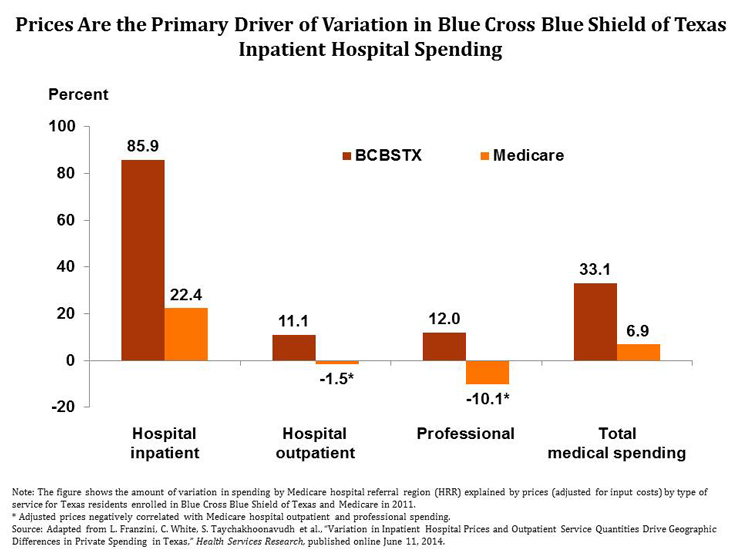Synopsis
Using newly available data, researchers examined variation in health care spending among Texas residents covered by a large private insurance plan or by Medicare. While price was the principal driver of overall spending variation in the privately insured population, the drivers within spending categories differed considerably. Price drove inpatient spending variation, but utilization of services drove the variation in outpatient and professional services, like physician visits, tests, and lab work. Among Medicare beneficiaries, spending variation was driven mainly by sicker patients’ greater use of health services.
The Issue
With health care costs accounting for almost 18 percent of the U.S. gross domestic product, improving the efficiency of the health system has become a priority, including efforts to identify the causes of unwarranted spending variation. While a sizable amount of research has focused on variation in Medicare spending, there has been less focus on private medical spending, even though it accounts for 55 percent of total health expenditures. For this Commonwealth Fund–supported study, researchers used newly released data from the largest private insurer in Texas, Blue Cross Blue Shield of Texas, as well as data on the Texas Medicare population, to examine the roles of price and service utilization as drivers of geographic variation in health care spending.
Key Findings
- Average total spending per member per year for Blue Cross Blue Shield of Texas was $3,702, of which 82 percent was medical spending and 18 percent was for pharmacy services. Of medical spending, 42 percent was for professional services, 32 percent for outpatient services, and 26 percent for inpatient care. Medicare medical spending per beneficiary per year was $6,717, 39 percent of which was for professional services, 18 percent for outpatient, and 43 percent for inpatient.
- Overall, variation in Blue Cross Blue Shield spending was driven largely by price differences. But while price variation was the primary driver of variation in hospital inpatient spending, care utilization was the most important driver of hospital outpatient and professional (mostly physician) services. Variation in drug spending was almost completely explained by utilization.
- Among Medicare beneficiaries in Texas, spending variation was driven primarily by utilization. Health status explains much of the Medicare variation, but it does not explain utilization variation within Blue Cross Blue Shield.

Addressing the Problem
"The conventional wisdom that Medicare does a better job of controlling prices and private plans do a better job of controlling volume is an oversimplification."
Strategies to manage variation in spending will necessarily differ depending on the health service and patient population covered. Measures aimed at improving the efficiency of health care delivery and reducing inappropriate utilization should be developed, although more research is needed to know which specific services are overutilized. When seeking to control spending variation for inpatient hospital services, policymakers might consider strategies aimed at reducing price variation, including those that strengthen competition or regulate payment rates. This could include expanding on efforts to improve the transparency of cost and quality data and redesigning benefits to give consumers incentives to use lower-cost providers.
About the Study
The research team used claims data from Blue Cross Blue Shield of Texas for more than 2 million members under age 65 who were enrolled in preferred provider organization (PPO) plans. The team also used publicly available data from the Centers for Medicare and Medicaid Services.
THE BOTTOM LINE
Because differences in private health care spending are driven both by price and by utilization, depending on the service category, tailored strategies are required to manage this variation. More in-depth study is needed in markets where prices or utilization are unusually high to identify the underlying drivers of potentially unwarranted costs.
